At the beginning of the trout season, witnessing the March Brown fly (Rhithrogena Germanica) gracefully descending the river with its wings meticulously drying, brings immense joy to my angling endeavours. This spectacle is made even more beautiful by the timing of its occurrence, which frequently makes for a fantastic fishing day.
The delicate dance of the March Brown fly serves as a testament to the wonders of nature and the harmonious balance that exists within the aquatic ecosystem. As the fly glides across the water’s surface, it entices the elusive trout to rise and strike, providing anglers with thrilling moments and the possibility of a rewarding catch.
This member of the mayfly family starts hatching in the middle of the month on the Welsh Dee. Often duns flutter off the water in short bursts over a few hours.
It’s rare for the bursts to last more than 20 minutes. So, it pays to be ready to fish a fair imitation.
Hatches continue through to mid-April, after which they won’t be seen for the remainder of the year.
Habitat & lifecycle of the March Brown fly
It starts life as a stone-clinging nymph, thriving in rocky well-oxygenated, fast-flowing rivers of Wales, Northern England, and Scotland.
The nymphs are not found in chalk streams, lakes, and reservoirs.
The lifecycle of the MB is similar to that of other up-winged flies:

- The nymph crawls out from its underwater habitat and swims to the surface (usually, between 11 am and 4 pm).
- At the surface, the nymph emerges from its shuck to transform into a dun.
- Duns sit on the surface while their wings dry, then fly off to find cover and mature into a spinner.
- Once mated, the female spinner flies upstream and lays eggs by dipping her abdomen onto the surface of the water. She does this either by landing on the water for short periods or flying just above the water’s surface.
- Finally, the spent female spinner falls onto the surface.
The egg-laying stage is usually at the end of the day and thus, is not that important to the fly fisher.
MB Nymph
Nymphs are found clinging to the underside of submerged rocks in fast-flowing water.
They are easily identified by their wide and extremely flat brown bodies (ca. 13 – 15mm long), broadheads, large upward-looking eyes, and three long tails.

It’s only when the nymph leaves the sanctuary of the riverbed to hatch that they are available for trout to feed on.
Typically, the hatch starts during the warmest part of the day and hungry…
Overwintered trout don’t miss the chance to feed on them.
Fishing MB nymph patterns:
While waiting for a March Brown fly hatch, I start fishing fast riffles and pool heads with a team of wet flies with either a gold-ribbed Hare’s Ear or pheasant tail nymph on the point.
A gold-ribbed Hare’s Ear nymph (sizes 14 & 12) is a good imitation of the MB nymph. So, which nymph patterns do I use?
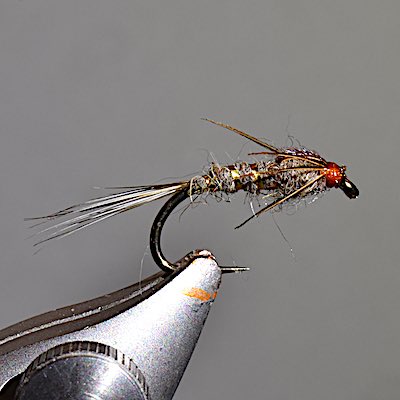
Gold ribbed Hare’s Ear nymph
- Hook: Kamasan B170 #14 & 12
- Weight: 4 turns of lead wire
- Thread: Rusty orange 8/0 Uni
- Tail: Badger cock fibres
- Body: WAPSI Hare’s ear
- Rib: Gold tinsel
- Thorax: Hare’s Ear dubbing
- Wing case & legs: 6 pheasant tail fibres
If you are new to fly tying, the following video by Davie McPhail on how to tie a good gold ribbed Hare’s Ear is well worth watching.
Alternatively, the following pheasant tail nymph pattern is an effective imitation
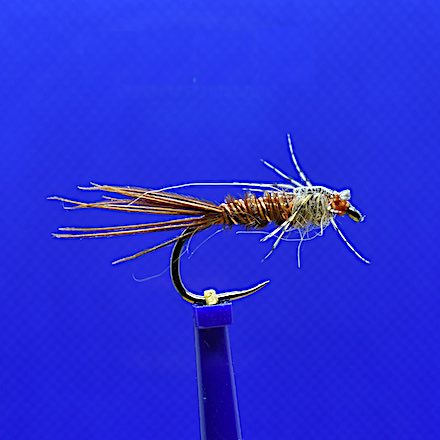
PL Pheasant Tail Nymph
- Hook – HENDS BL354 (#12 to 16)
- Thread – Tan 8/0 Uni
- Tail – pheasant tail fibre tips
- Body – pheasant tail fibres
- Rib – fine copper wire
- Thorax – Hare’s Ear dubbing
- Legs – Partridge neck feather
- Wing case – WASPI Mottled Oak Thin skin
Note – if you are buying nymphs select ones that have been tied with a thin body profile of ca. 3 mm max.
In fast streamy water, a heavier pattern might be needed to reach fish nymphing close to the riverbed. In this case, I normally fish a pheasant tail jig nymph sporting a heavy tungsten bead.

Pheasant tail jig nymph
- Hook – HENDS BL154 (#12 & 16)
- Bead – 2.5mm tungsten (silver & gold)
- Thread – Brown UNI-Thread 8/0
- Tail – 3 pheasant tail fibre
- Tag – Orange floss (optional)
- Body – pheasant tail fibres
- Rib – Fine copper wire
- Thorax – Olive dubbing
It’s a versatile pattern, which I tie with and without the orange tag and using a range of coloured tungsten beads (i.e. neutral, silver, gold, and copper).
Usually, when trout start taking the flies on the surface it is more productive to switch to fishing the…
March Brown fly – Dun
Identification of the MB dun is quite easy because apart from the Large Dark Olive and the Large Brook Dun it is often the only other fly on the river at this in early spring.
The MB dun is identified by its dark brown body (ca. 10mm long) with olive bands, two tails, and mottled brown wings. Whereas, the LDO has pale grey wings with brown veins and is a bigger fly.
In April the March Brown fly can be confused with the Large Brook Dun which is very similar in colour and size. However, the fly angler doesn’t need to be concerned because you can use the same dry fly pattern to imitate both natural flies.
Fishing for trout feeding on emerging duns
As the day warms, MB nymphs begin to swim to the surface to hatch in short bust between ca. 11 am and 4 pm. So, it pays to be ready to fish a good imitation.
The nymph transforms into a dun by unfolding its wings and floats on the surface while its wings dry. At this stage the duns they are…
“Easy pickings for trout”
Fish take the March Brown fly as it emerges or while it’s waiting for its wings to dry.
If your dry fly should start to sink wait a few seconds before recasting because the dry fly will also be taken as it drowns.
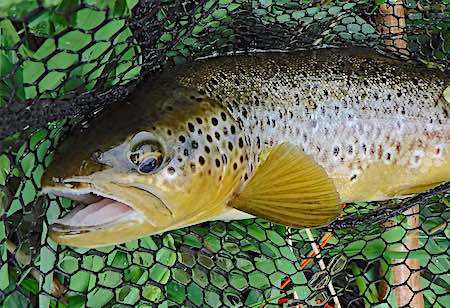
The best hatches of MB flies occur at the heads of pools fed by oxygenated water and in the riffle sections of rocky rivers.
Examples of such pools on the Welsh Dee include:
Studying the aforementioned pools will provide a clear understanding of what pools to look for on other rivers.
Wet fly/spider fly fishing
In spring, I’m usually on the river by 10 am because these fishing trips involve a long drive and I like to maximise my time on the river.
I’m always eager to wet a line, and as such, I often start by fishing a nymph on the point of a team of wet flies and/or North Country spiders. Usually, this approach catches a few trout before MB begin fluttering off the river, and I switch to dry fly fishing.
My standard three fly cast for trout feeding on MBs consists of the following flies spaced 3ft apart on a 3 lb copolymer leader (point fly – #14 gold ribbed Hare’s ear; middle dropper – #14 MB spider; top dropper: #14 wet March Brown fly).

Fishing this team upriver is often deadly during the early stages of a hatch of MB. Especially when trout are feeding on emerging insects and ignoring those sitting on the surface drying their wings.
When you’re not comfortable fishing a team of wet flies, it is best to fish a single MB spider or wet fly.
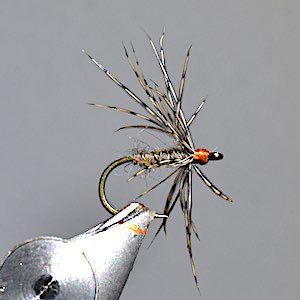
MB Spider
- Hook: Partridge L3A-S #14
- Thread: Rusty orange UNI 8/0
- Body: WAPSI Fox Squirrel
- Rib: Glod wire
- Hackle: Brown partridge neck
The aforementioned sparsely tied MB spider is a highly effective imitation and is my default fly. However, if it doesn’t catch any trout after 10 to 15 minutes I will change it for the following wet fly…
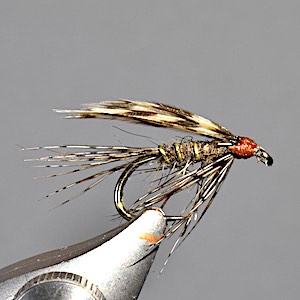
March Brown fly (wet)
- Hook: Kamasan B170 #14 & #16
- Thread: Rusty orange 8/0 Uni
- Tail: Grey partridge fibres
- Body: WAPSI Fox squirrel
- Ribe: Gold wire
- Hackle: Brown partridge neck feather
- Wing: Peacock Wing feather slips
Dry fly fishing
If you’re a dry fly fishing purist, spring is a civilized time of the year because the MB is a late riser, with hatches rarely starting before 11 am and over by 4 pm. Therefore, there’s no need for…
An early start or late finish on the river.
Overwintered, hungry trout waste little time intercepting MB as they appear on the water, which is often triggered by a subtle rise in air temperature.
Typically, March Brown fly hatches occur as short bursts of flies rather than a constant stream. Also, the hatch can be very localized to short sections of the river.
Therefore, it is best to cover as many pools as possible in search of a hatch and rising trout. Once found, fish the pool thoroughly until it’s exhausted and then move on to a new location.
It’s always wise to avoid spooking rising trout but the dry fly presentation to hungry brown trout is often straightforward. Even a…
Poorly presented fly is engulfed as it passes overhead.
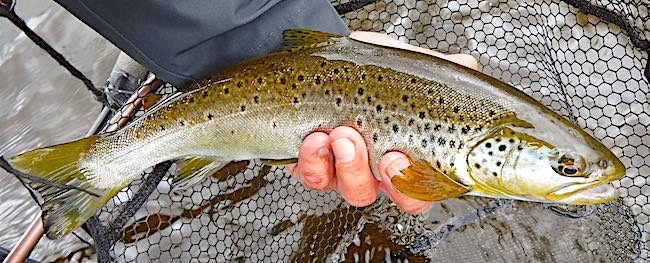
At this time of year, a simple dry fly leader set-up will often suffice. The one I use is made up of a 9ft 4X tapered copolymer leader with 2-3ft of 3lb fluorocarbon tippet tied onto the end.
Now, let’s take a look at my dry fly choice…
Dry fly patterns:
Fortunately, a multitude of dry fly patterns is not required to successfully imitate the March Brown fly. I’ve caught plenty of trout and grayling using the following three patterns, which are relatively easy to tie.
For trout feeding on emerging duns, I use the MB upright, since its body lies under the surface of the water with the dear hair wing protruding above the surface.
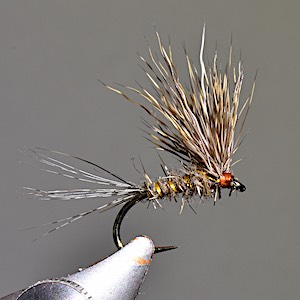
March Brown Upright
- Hook: Kamasan B170 #14 & 12
- Thread: rusty orange 8/0 Uni
- Tails: Grey Partridge fibres
- Body: WAPSI Fox Squirrel
- Rib: Gold floss
- Wing: Deer hair
If trout ignore the MB upright dry fly I switch to fishing the following Elk hair caddis pattern, which fishes on the surface.

Elk Hair Caddis fly
- Hook: Kamasan B170 #14 & 12
- Thread: Brown 8/0 Uni
- Tails: Cream Antron yarn
- Body: Hare’s Ear
- Rib: Gold wire
- Wing: Elk Hair
- Head: Olive seals fur substitute
If both the large dark olives and March Brown fly are hatching simultaneously, I opt for the Jingler fly because it’s an acceptable imitation of both flies.
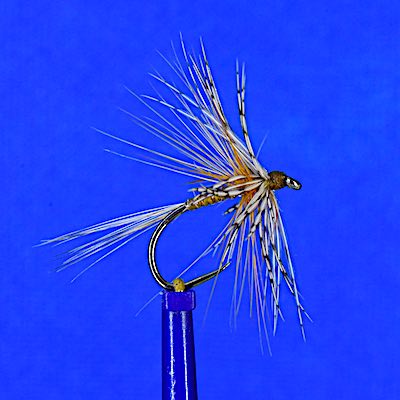
Jingler
- Hook: Kamasan B170 #14 & 12
- Thread: Olive 8/0 Uni
- Tails: Badger cock fibres
- Body: Hends body quill BQ-32
- Hackles: grey partridge & ginger cock
It’s important to tie the front partridge feather facing backwards so it concaves forwards over the eye. This produces a bushy Jingler that trout find more attractive.
If you are unable to tie or get hold of the above patterns, many outlets are selling MB dry flies (size 14), which will catch early-season brown trout.
March Brown fly – Spinner
The female MB spinner has a brown body with tan-coloured rings and transparent brown-veined wings. After mating, she will lay her eggs during the hours of darkness, therefore it’s uncommon to see large quantities of spinners.
As such, spinners are often of little significance to the fly fisher.
However, on the occasions trout are spotted taking spinners that have been blown onto the river, they can be tempted using a size 14 pheasant tail spinner.

Pheasant tail spinner
- Hook: HENDS BL345 #14 & 16
- Thread: Olive UNI-Thread 8/0
- Tail: Ginger cock
- Tag: Pearl Mylar
- Body: Pheasant tail fibres
- Rib: Fine gold wire
- Wing: Cream Antron yarn
Finally, I hope you have found this article interesting and it would be great to hear about your successful March Brown Fly patterns.
Acknowledgements:
Lewis Newton for the image of the March Brown Dun.

Great insight in to the March brown hatch, thanks!
Hi Steve,
I’m glad you enjoyed the post and thanks for the feedback.
Cheers, Andrew
very good as usual ,all good information
Hi Colin,
Thanks – I just hope we are all able to go trout fishing at the start of the season and see a few March Brown flies fluttering off our rivers.
Cheers, Andrew
Great article Andrew it really extends the season having a good plan of attack for March and April with these flies
Hi James,
Glad you enjoyed the article. More posts on key flies for each month are in the writing pipeline, so keep an eye out.
Cheers, Andrew
Hi all emails are excellent ,in particular the March Brown one which I am sharing with our local club students on our Angling Trust Cast Fly Fishing course as it brilliantly explains the life cycle and matching the hatch and enthuses fly tying
Hi Bob,
It great to hear that you are enjoying the posts and that they are good enough to share with your students.
Cheers, Andrew
Your posts are most insightful and welcome at any time, thank you! Hope you get the success that your hard work deserves!,
Hi Chris,
It’s great to hear you found the post interesting and useful.
Cheers, Andrew
Here in the East (Maine, Rhode Island) the march brown is the best fly to use. It always produces Trout.
Hi Rob,
Great to know that this great fly works in the US.
Cheers, Andrew
Another really informative article. As someone new to fly fishing I’ve really enjoyed articles on Winter grayling, now Spring trout are round the corner. Keep up great work
Thanks for the feedback.
Hi Andrew, thanks for a most informative and thorough article. I have forwarded it to a friend who fishes the R.Nidd near Harrogate, as M.B. fly together with Water Hen Bloa and Snipe & Purple are good early season flies there too.
Hi Alan,
It’s great to hear that you found the post interesting and thanks for sharing it with one of your friends.
Cheers, Andrew
Very informative, thank you.
Great to hear you enjoyed it.
A genuinely useful article with great flies!
Hi Paul,
Pleased to hear you enjoyed the article and thanks for the feedback.
Cheers, Andrew
A very interesting and useful post as usual. I hope it works well on the rivers in Belgium too!
Hi Foghel,
If you try them out on rivers in Belgium it would be good to know how you get on.
Tight lines, Andrew
Another great pattern to tie, thanks Andrew
Cheers
Thanks for sharing this, as a new tier detailed information and patterns like this is hard to find in one place.. thanks again
Hi Gary,
Great to hear you are enjoying my blog and website. Just let me know if there is anything you would like me to cover.
Tight lines, Andrew
Hi Andrew,
always good to read your articles and although I have read this one before or at least something very similar it was good to see your tying patterns which has stimulated me to tie up some of each pattern for my match on the River Tees at the beginning of April as I had to weed out some 1460 flies from my river boxes as we have to use only manufactured barbless hooks as opposed to just crushing and filing down the barbs.
Good luck on the Tees. Andrew
Always great and informative articles for even us in US.
patterns are unique and easy tied.
Thank you for insight into March Brown
Pleased that you enjoyed the post.
Tight lines, Andrew
Hi Andrew, very interesting and has given me a better understanding of the March Brown. Now I just have to put it into practice. Thanks. Ken
Hi Ken,
Great to hear that you enjoyed it. They should tempt a few fish.
Tight lines, Andrew